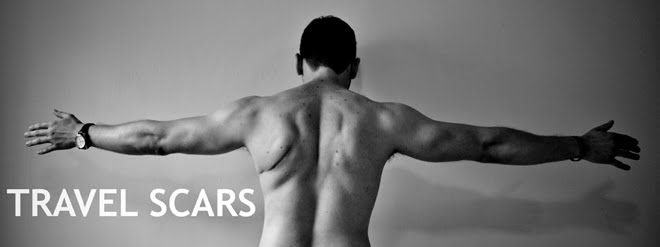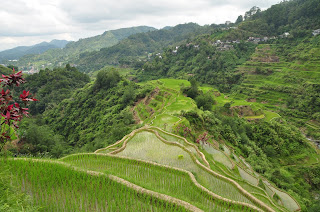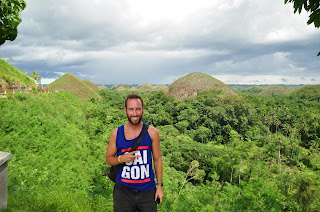Our time in the central islands of the Philippines had come to an end. We woke up at the break of dawn and were shuttled to Coron's airport in the middle of nowhere. Our morning flight would be bringing us back to Manila and back to the island of Luzon, where we would be heading to the north of the island for our final time in the Philippines.
Once back in Manila, we immediately made our way to the bus station and hopped on a bus headed north to Vigan, our first destination. Even though Vigan is 405km away from Manila, the mountainous roads of the Cordillera region made the drive slow and it took us between 7-10 hours to finally get to our destination.
We arrived after dark and hadn't made any reservations. We took a taxi to the area where our desired accommodation was located and hoped for the best. The door was locked and we had to wait outside until someone opened up the door. Thankfully, they had one room left and I jumped on the opportunity. It was considerably fancier than the places we were used to and was a heritage building.
Vigan, not to be confused with those non-animal-based-product-eating hippies, is a city that was captured and settled by the Spanish in 1572. It grew in power and influence and became the seat of the Diocese of Nueva Segovia in 1758. It was spared from bombing in World War II and as a result, Vigan still maintains much of its original colonial charm; including cobble-stone roads, Spanish-era villas and also uses kalesa (horse drawn carriages) as well as trikes.
Because of this high degree of preservation, it was named a UNESCO World Heritage Site in 1999, being the best preserved Spanish colonial town in all of Asia.
We started our day just sauntering through the cobble-stoned streets and admiring the colonial architecture. We eventually came across a small nondescript church with an extravagant graveyard behind it.
It was surprisingly interesting to wander around and see the elaborate crypts, tombs and tombstones.
From there we went to Plaza Burgos, a tribute to Father Jose Burgos. This was right across the street from St. Paul's Cathedral and the Archbishop's Palace.
From there we passed City Hall and stopped to take some pics in front of the Plaza Salcedo and its impressive fountain.
Our next stop was the most interesting of the day: the Provincial Jail. This colonial-era building was still in use but could also be visited by tourists. We assumed it wasn't for dangerous offenders because we got to tour a basketball court and saw a large group of prisoners watching TV.
After a great breakfast at our hotel, we headed for Baguio, our layover stop before heading deeper into the Cordillera region of Luzon.
Baguio is a bustling university town and was founded as a hill station for the US military in the early 1900s.
We arrived near nightfall so the landscape was rather obscured, but two things were for sure: 1) Baguio was extremely hilly (there were no trikes to be seen) and 2) there was a ton of traffic.
We settled on a place called Blue Mountain Hotel and were eager to have a night on the town. Being a university town at the very beginning of the semester, we expected the night life to be the stuff of legends.
We started our evening by eating at Cafe by the Ruins. This restaurant was a little more high class than we were used to, but the food and the ambience were second to none. We ran into a little problem when we ordered drinks with our meal, because the waiter informed us that they didn't serve alcohol.
Being extremely resourceful, Mike went off into the night and procured us a 6-pack and came back into the restaurant. The waiter saw, and was not impressed. We stated that we would have gladly purchased them from the restaurant if they had offered them. After some friendly exchange, he finally agreed, but told us we would have to drink it from nondescript glasses. Fair enough.
We had heard about a really popular student bar district and we decided to find it. For some reason (most likely frugality), we decided to walk and find it rather than take a taxi. We walked around for probably over an hour until we finally stumbled upon this mecca of partying.
Unfortunately, the 3-4 bars in this complex were virtually empty! It turns out that we had in fact showed up one week too early for the beginning of the semester, and as a consequence, missed all the first-week shenanigans.
We did finally go into one bar jam-packed with 4 other people, including one not so convincing lady-boy, and I ended up dancing on stage with everyone while Mike took pictures of this sorry spectacle.
The following day, were were off to Sagada, the Cordillera's natural wonderland. It has been alluring us with caving, hiking, waterfalls and fascinating hanging coffins (more on that later), but first we had to get there.
We took an almost 6-hour bus ride from Baguio to Sagada. Considering it is only 150km away, you can imagine the condition of the roads and the speed of the bus. However, the mountainous landscape really makes up for it.
We finally arrived to Sagada and were blown away by the quaint atmosphere and chill vibe that this place radiated.
We found a guesthouse near the bus station and started to explore. We had three goals for Sagada: to go caving, see hanging coffins and chill as much as humanly possible. Our first afternoon and evening, we did the third one hard.
The next day we arranged to do the cave connection, which is caving where you start at Sumaguing cave and finish at Lumiang cave, never coming to the surface in between.
At the caving office, it recommends that people who were out of shape or fat should not attempt this rigorous excursion, but we were two svelte young studs so we thought it would be a piece of cake.
Near the entrance of the first cave we saw what appeared to be a pile of coffins. At a closer glance, it was in fact a pile of coffins. Apparently the ancient inhabitants of these lands keep their dead near the mouth of the cave in order for them to "see the light" and be directed to heaven.
From there it got progressively darker, and we were now fully in the cave and would have to rely on our guide to get us out of there in one piece.
We passed many stalactites and stalagmites and many other rock formations. Some of these included a pseudo maple leaf that brought a patriotic tear to our eyes, as well as a rock formation that really resonated with the environment: that being dark, tight and wet.
We were underground for a few hours before finally approaching the opening of Lumiang cave. It was quite spectacular being able to traverse the earth without seeing the light of day for so long.
Once outside, I posed next to our first taste of the region's famed rice terraces with our guide and we made our way back to Sagada.
Once back to Sagada, we were immediately in search of the famed hanging coffins. The ancient inhabitants of this region, the Igorot tribe, have been doing this ritual for hundreds if not thousands of years. It was believed that it was done in order to keep the bodies closer to the spirits, but others speculate it could have been done to prevent ground water from seeping into the coffins or more interestingly, for keeping the coffins away from rival head-hunting tribes who would come in search of trophy heads.
Another interesting observation is that the coffins were around half the size of what we would consider normal sized adults. While I know Filipinos are among the shortest people in South East Asia, this was a little extreme. Then we thought that perhaps they only buried children in this manner, but that was also misguided. It turns out that people in this tribe buried their dead in the foetal position because they believed that they should leave this world as they entered it. Pretty amazing concept.
One of the highlights of our time in Sagada (at least for me) was Bana's cafe: a local cafe with balcony overlooking a gorge and coffee plantation. Not only did they have a beautiful view, but some of the best coffee I've had since Vietnam.
It was already time to leave wonderful Sagada, and also drawing closer to the time where Mike would no longer be my travelling partner.
We took a jeepney to Bontoc, a sleepy little transit town where I saw a woman with two thumbs. From there, we continued onto Banaue, our intended and final destination on our Philippine adventure. The scenery on this ride, and in the Cordillera region as a whole, was absolutely fantastic.
We arrived in the afternoon and checked into Uyami's Green View Lodge. The room we had was decent, but the view from the lodge's balcony was simply breathtaking. I must have taken a picture of that view with every possible lighting imaginable.
Banaue is the base for exploring the Ifugao rice terraces. These ancient rice terraces were built and carved into the mountains of the Ifugao mountains over 2000 years ago. They have been called the 8th wonder of the world by some (probably Filipinos), and are a UNESCO World Heritage Site since 1995.
The Banuae rice terraces are featured on the 20 peso banknote but while researching for this post, they are not on the UNESCO list because of the modern reparations made to these ancient structures. UNESCO is obviously very difficult to please. I still find them immensely impressive.
Mike and I took a jeepney to Banaue's famed lookout point and took it all in. We had the great idea that instead of walking down the road like suckers we would walk through the terraces on our way back towards the town. It was all downhill so that should have been fairly straightforward. At least we thought it would be.
Every time we thought we were going in the right direction, we ended up at a dead end or impenetrable pass. It eventually became quite frustrating trying to figure out how to get down.
Because it is still actively used in farming in this region, many of the terraces are submerged in water. While I motioned for Mike to step out onto the edge for an epic pic, he tried to step around me, and instead stepped into a huge puddle of mud and was knee deep in it. I laughed accordingly.
After wandering onto private property more times than we intended, we finally made it back onto the road down to Banaue, and just in time too, because it started absolutely pissing rain.
The following day we arranged to do a trek from the Banaue region to Batad, one of the actual UNESCO rated rice terraces.
The walk there was absolutely stunning. Not only did we get to see the entire region only accessible by foot, but we also had a local guide who made sure that we didn't get lost or wander onto people's land.
When we finally got our first glimpse of Batad, Mike and I were literally speechless. That's rare for Mike. He never shuts up. I would go in to a description, but I think the picture speaks for itself.
We stood and gazed at this marvellous mixture of natural and man-made wonder. Our guide then asked if we wanted to visit the Tappiya waterfall. Since it was hot as balls, we thought it was a no-brainer.
It was a piece of cake because it was all downhill and when we saw the impressive 30m falls, we could not have been any happier.
Seeing as though I was happy, Mike decided to rain on my parade. I asked if he could take a picture of me standing in front of the falls. Since he was already making his way into the water, he bluntly declined. The result is that weird angle shot of me using a self-timer and rock for balance. I can distinctly remember at that moment that I was happy he was leaving the next day.
That wasn't true. His time to leave the Philippines and his role as my travel buddy had finally come to an end. Our three-and-a-half month adventure through 5 countries (Vietnam, Malaysia, Singapore, Myanmar and the Philippines) had gone swimmingly well. The non-stop laughs and wise-cracks made this portion of my journey unforgettable and hilarious. Mike and I have travelled several times before this trip, and I hope we will continue to meet up elsewhere in the world in the future as well.
On my final day in the Philippines, I met an American traveller named Jeff and we did some small hikes between the villages of Tam-an, Poitan and Bocos. It was fun, but I was already missing Mike.
Now that I had reached my final day in the Philippines I can honestly say that this country blew my mind and exceeded all of my expectations (except for the food, I didn't find it anything special). I have barely scratched the surface of this 7000-island nation in the month-and-a-half that I was there. I decided that the best way to get over my sadness of not visiting every island, was to visit a country with 10,000 more islands than the Philippines. Next stop: Indonesia!




























































